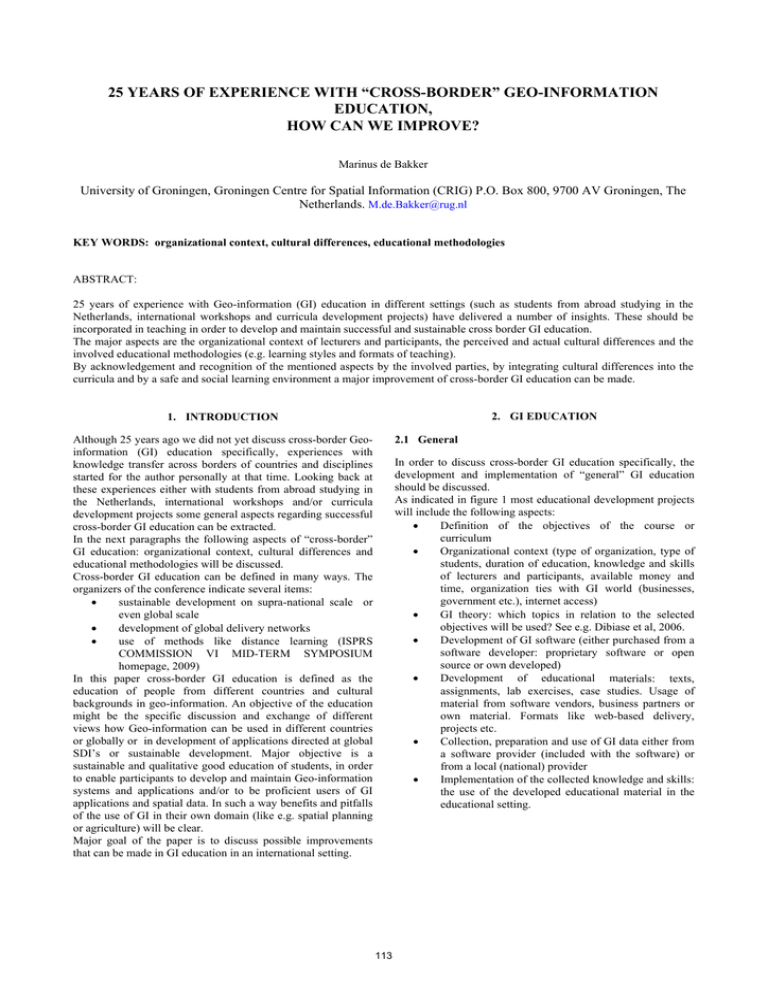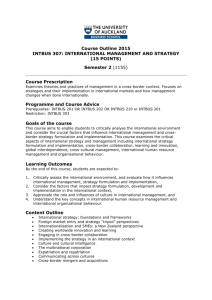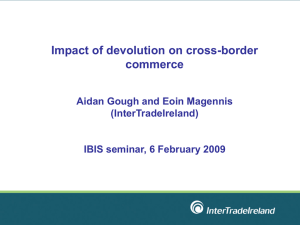25 YEARS OF EXPERIENCE WITH “CROSS-BORDER” GEO-INFORMATION EDUCATION, HOW CAN WE IMPROVE?
advertisement

25 YEARS OF EXPERIENCE WITH “CROSS-BORDER” GEO-INFORMATION EDUCATION, HOW CAN WE IMPROVE? Marinus de Bakker University of Groningen, Groningen Centre for Spatial Information (CRIG) P.O. Box 800, 9700 AV Groningen, The Netherlands. M.de.Bakker@rug.nl KEY WORDS: organizational context, cultural differences, educational methodologies ABSTRACT: 25 years of experience with Geo-information (GI) education in different settings (such as students from abroad studying in the Netherlands, international workshops and curricula development projects) have delivered a number of insights. These should be incorporated in teaching in order to develop and maintain successful and sustainable cross border GI education. The major aspects are the organizational context of lecturers and participants, the perceived and actual cultural differences and the involved educational methodologies (e.g. learning styles and formats of teaching). By acknowledgement and recognition of the mentioned aspects by the involved parties, by integrating cultural differences into the curricula and by a safe and social learning environment a major improvement of cross-border GI education can be made. 2. GI EDUCATION 1. INTRODUCTION Although 25 years ago we did not yet discuss cross-border Geoinformation (GI) education specifically, experiences with knowledge transfer across borders of countries and disciplines started for the author personally at that time. Looking back at these experiences either with students from abroad studying in the Netherlands, international workshops and/or curricula development projects some general aspects regarding successful cross-border GI education can be extracted. In the next paragraphs the following aspects of “cross-border” GI education: organizational context, cultural differences and educational methodologies will be discussed. Cross-border GI education can be defined in many ways. The organizers of the conference indicate several items: sustainable development on supra-national scale or even global scale development of global delivery networks use of methods like distance learning (ISPRS COMMISSION VI MID-TERM SYMPOSIUM homepage, 2009) In this paper cross-border GI education is defined as the education of people from different countries and cultural backgrounds in geo-information. An objective of the education might be the specific discussion and exchange of different views how Geo-information can be used in different countries or globally or in development of applications directed at global SDI’s or sustainable development. Major objective is a sustainable and qualitative good education of students, in order to enable participants to develop and maintain Geo-information systems and applications and/or to be proficient users of GI applications and spatial data. In such a way benefits and pitfalls of the use of GI in their own domain (like e.g. spatial planning or agriculture) will be clear. Major goal of the paper is to discuss possible improvements that can be made in GI education in an international setting. 2.1 General In order to discuss cross-border GI education specifically, the development and implementation of “general” GI education should be discussed. As indicated in figure 1 most educational development projects will include the following aspects: Definition of the objectives of the course or curriculum Organizational context (type of organization, type of students, duration of education, knowledge and skills of lecturers and participants, available money and time, organization ties with GI world (businesses, government etc.), internet access) GI theory: which topics in relation to the selected objectives will be used? See e.g. Dibiase et al, 2006. Development of GI software (either purchased from a software developer: proprietary software or open source or own developed) Development of educational materials: texts, assignments, lab exercises, case studies. Usage of material from software vendors, business partners or own material. Formats like web-based delivery, projects etc. Collection, preparation and use of GI data either from a software provider (included with the software) or from a local (national) provider Implementation of the collected knowledge and skills: the use of the developed educational material in the educational setting. 113 GI theory in itself will not be different, but the organizational context influences the cross-border content. This will be more extensively discussed in part 3. The implementation of cross-border GI education certainly is different. Time should be spent to check if the differences between groups of students are dealt with. An example is that a lecturer should not leave the classroom immediately in order to give students the possibility to ask questions without “loosing face”. The degree of flexibility should be higher, because planning is dependent on the wide range of levels of cooperation and skills of the students. GI theory Objectives of Development educational materials Development GI software GI Implementation (knowledge & Skills) education GI data provider GI data local GI data real case Organizational context 3. ORGANIZATIONAL CONTEXT Figure 1. Overview development and implementation of GI education Cross-border GI education is even more influenced by the organizational context. Major reason is that most aspects (as defined above) are embedded in a national and specific cultural situation. If the educational organization has the objective and facilities to deal with cross-border education on different levels (like e.g. international oriented secretariat, support to bridge gaps in missing knowledge and skills, open atmosphere of exchange) it can be a success. If it also facilitates the extra development and time needed for the realization of the education, it will deliver even a better result. Several examples that make this clear will be illustrated below. Opening hours of the facilities (also regarding holidays) should be communicated specifically. Visiting faculty staff without specific knowledge about the knowledge level and expertise of students and just drop in with their “foreign” experiences will not be successful. Another example is the availability of free geo-data. Legal aspects will influence e.g. the emphasis on how to collect, maintain and digitize data. A short intensive course (especially supported by e-learning) will not have many possibilities to discuss specifically the cross-border aspects. Most of these should be included in an indirect way (e.g. a link to explain the role of a Dutch waterboard in water management). The availability of hardware in connection with software and internet access will change the cross-border aspects in education dramatically. If the access to the outside world is possible, lots of existing material can be used. The role of the lecturer will change, not anymore mostly developer and publisher, but coach and evaluator of materials collected and used by the students. Major conclusion regarding the organizational context is that not only the education itself should be adapted, but also the educational environment. Such a process seems straightforward, but in practice several iterations and evaluation cycles are necessary, before a solid and sustainable course or curriculum is realized. 2.2 Cross-border The development and actual execution of GI education in a cross-border context as defined earlier is different. Even though the technical overlay function is exactly the same, contents and approach could be and often is different. Each aspect that (according to the experiences of the author) should be handled differently (see figure 2) will be discussed. GI theory Objectives of GI Development GI software Development educational materials Implementation (knowledge & Skills) education GI data provider GI data local GI data real case Organizational context Figure 2. The aspects of development and implementation influenced by a cross-border context (in darker colours) Regarding the definition of the objectives, it is very important to discuss if cross-border aspects are an integral part of the GI education. E.g. just admitting participants of abroad in an already established course will be difficult. All material must be screened for relevance and usability for participants with different backgrounds. Several times Dutch students complained that extra time is needed to explain the background. Cooperating with foreign students cost extra effort. Examples like the use of cadastral data or specific water management case studies are notorious. It takes more than simply translating the educational materials. There sometimes is a need for specific new material, which is not beneficial for all students. The more the lecturer is knowledgeable about the situation of the participants, the fewer problems arise (if time is available for update and transformation). If the course simulates an international topic like climate change or SDI, the cross border aspects can be integral linked into the objectives. E.g. how to manipulate the aspects of different projections and datums of adjacent countries. 4. CULTURAL DIFFERENCES As discussed extensively by Hofstede (amongst others, 2004), cultural differences and experiences influence the efficiency and effectiveness of the educational process. If the cultural barrier between students is very high (as seen in figure 3, A), results of the educational assignment is seen different. Student A may be happy, although student B expects more. 114 Stated assignment western student. In such a way he or she hands over the powerbalance. Another difficulty is the balance between the value of reality versus the supposed GI objective of a case study. Some students like only case studies where both aspects are integrated. Without hard experimental data it seems to the author that again the above mentioned differences will collude with south (integrated) versus west (separation). Stated assignment Student A Student B Student A Student B Context & Experiences A Context & Experiences B Context & Experiences A Context & Experiences B 6. CONCLUSIONS Solution A: barrier The answer regarding the major question of this article “How can we improve cross-border GI education?” is not without bias from the author’s experiences. Some people will state that the discussed aspects are not global applicable or cannot be changed. But experiences show that if lecturers and students use best practices (especially the passion to know what happens during the educational processes between and inside the participants) cross-border GI education will fulfil its expectations. Awareness of the context of the student in crossborder GI education is even more important compared with “national” GI education. Solution B: cooperation Figure 3. Process of education in different cultural context, regarding barrier (A) or cooperation (B) In a cross-border GI educational set-up, specific attention should be given to differences in computer skills and the role of the map (cartography) in the culture. To delete a map with sensitive data (seen as an intermediary product that can be discussed extensively) in a culture where possession of maps is the existence of power will not be understood. Cultural differences cannot (and should not) be eliminated during cross-border education, but can be used to show the range of possible users and usages. It is important to create a mutual understanding for the existing differences. An example is that during an introduction lecture several students could illustrate the role of maps and their institutions and their countries. Another example is to plot the students perceived location on the index as used by Hofstede (power distance; individualism versus collectivism; masculinity versus femininity; uncertainty avoidance and long term orientation). In general technical GI education will go easier compared with organizational issues (e.g. GI project management). 7. REFERENCES References from Books: Dibiase, David, Michael DeMers, Ann Johnson, Karen Kemp, Ann Taylor luck, Brandon Plewe and Elisabeth Wentz (editors), 2006. Geographic information Science and Technology Body of Knowledge, Association of American Geographers and University Consortium for Geographic Information Science (UCGIS). Hofstede, G. and G.J. Hofstede, 2004. Cultures and Organizations: Software of the Mind, New York: McGraw-Hill USA Kolb, David, 1984. Experiential learning: Experience as the source of learning and development. Englewood Cliffs, NJ: Prentice-Hall. 5. EDUCATIONAL METHODOLOGIES Students learn differently, partly because their background and earlier experiences, but also because they have a different approach. In GI education my experience shows that the chosen methodologies influence the results. Most of the GI educational materials from software vendors (e.g. Virtual Campus courses of ESRI Inc, 2010) follow the following structure: 1. introduction; 2. process with explanation with buttons, 3. next process. So students have to follow predefined processes, which are not always recognizable. If this processes are not repeated in a familiar context (e.g. their own discipline and example of a well known application or problem), the objective is not internalised. Some students prefer to learn using GI software by exploring the functionalities, especially linked to their (perceived) needs. In this case, especially the methodology of self learning and finding of resources should be emphasized. Above two examples are related to learning styles (Kolb, 1984). In cross-border education it is even more important to discuss and assess learning styles, so that if students with a different cross-border background have to work together, they will be familiar with the impact of these styles. This is even more important if an actual or perceived experience level is present. An example that occurs quite often is a student from a southern country too easily giving the charge of the computer mouse to a References from websites: ESRI Inc, 2010. Training Virtual Campus, http://training.esri.com/gateway/index.cfm?fa=main.home, (accessed 12 April, 2010) ISPRS COMMISSION VI MID-TERM SYMPOSIUM homepage, 2009. http://www.itc.nl/isprscom6/symposium2010, (accessed 12 April, 2010) 8. ACKNOWLEDGEMENTS The author would like to thank all students (from whatever country) during the more then 25 years of experiences in GI for their fruitful discussions regarding best practices in GI education and applications. The many fellow lecturers (e.g. at the EUGISES seminars) are acknowledged for their different opinions and views on the same subject. 115


